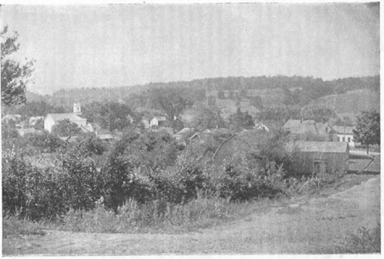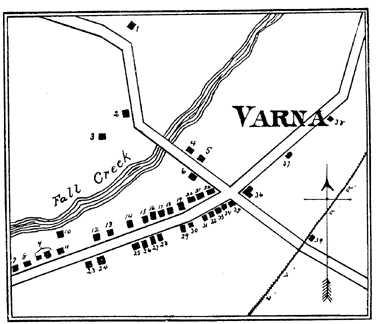February 19, 2004
Varna's history, to 1897
Since the Town Planning Board will be looking at Varna's future tonight, it seemed like an appropriate day to post George Goodrich's history of its past. (I'm still typing in Etna's chapter.)
In a first, I've scanned in the pictures and map for the section. I'll need to go back to earlier pieces I've posted and add the pictures. I think this picture illustrates the source of Varna's current difficulties quite well, though:
The road used to be small, and peaceful. It's neither today.
There's also a comment in the history that "the proximity of Varna to Ithaca has always interfered with its prosperity as a business center," which is still true.
| Key to the Map of Varna | |
|---|---|
| 1. Geo. E. Underwood. | 21. Wagon Shop. |
| 2. Ezra Ostrander. | 22. School House, No. 18. |
| 3. Ezra Ostrander. | 23. Marenus Crutts. |
| 4. Mrs. Cooper. | 24. W. C. Ellis. |
| 5. Wm. J. Manning. | 25. J. Pierce. |
| 6. Wilson Baker. | 26. Mrs. S. Grover. |
| 7. Frank Powers. | 27. O. T. Ellis. |
| 8. Philip S. Snyder. | 28. Seaman & Snyder. |
| 9. Mrs. Olive Crutts. | 29. M. E. Church. |
| 10. Grist Mill. | 30. M.E. Parsonage. |
| 11. Wagon Shop. | 31. Wm. J. Manning. |
| 12. Marenus Crutts. | 32. Geo Brown. |
| 13. Marenus Crutts. | 33. Mrs. Isaac Creamer. |
| 14. Geo. Underwood. | 34. Mrs. Sherwood. |
| 15. Robert Smiley, Postoffice. | 35. Frank Ellis. |
| 16. Ernest Snyder. | 36. J.T. Morris. |
| 17. Milo Williams. | 37. Will Ross. |
| 18. H. Brink, Store. | 38. Frank Hazen. |
| 19. J. Whipple. | 39. Depot. |
| 20. Blacksmith Shop. | |
Chapter XXXII.
Varna and Fall Creek.
The annals of the early settlement of Varna seem to be hopelessly lost. We cannot even obtain a hint as to the origin of the application of its name to this locality, the only Varna of which we have any knowledge being a Bulgarian city of that name on the shore of the Black Sea. It, however, had an early history, and among its first settlers were men by the name of Dyer, Jarvis and Blue, followed by Ebenezer Brown, Erasmus T. Brown, Jonathan Knowles, James Bird, Gen. John Munson, Peter Talmadge, John Ewers, Dr. Call, James McElheny, Wm. H. Miller, Walter Dowe, Dr. Ide, Dr. Pomeroy, William Cobb, William Schutt and Issac Creamer.
Both the first saw-mill and the first grist-mill are said to have been built by Gabriel Cain, in 1803, the former near the site of the Hart mill, where Amos Ogden, in later years, first instituted the custom of putting up flour in cotton sacks, for which paper has been substituted. The first tavern seems to have been built by a man by the name of Abner Chapin, near the site of the present hotel, in 1806, but the present hotel building was built by James McElheny in 1832, the first school house having been erected two years before on the opposite side of the street. On the site of the Crutts grist-mill there was constructed a saw-mill in 1818 by Gen. John Munson, and a sash factory was built in 1837 by Erasmus Brown, which was later occupied by Israel Brown as a distillery. Gen. Munson had a store in 1831 on the site now occupied by the Whipple blacksmith shop, the first blacksmith shop of which we have any record having been built by William Van Sickle in 1830. A tannery was built and operated by Z. Hartsough in 1840, followed by the building of the M. E. church in 1842 and the Presbyterian church in 1843.
The proximity of Varna to Ithaca has always interfered with its prosperity as a business center, but there was a time, near the middle of our Century Period, when it had quite a business of its own. In those days it was a great horse market, and many a drove of horses was started from there to New York in the old-fashioned way, some twenty-five horses more or less being attached with yokes to long rope at the head of which was a leader on horseback, and a man with a cart or wagon attached to the other end of the line brought up the rear, while horses in pairs were attached to the rope all the way between. Such a troops of horse starting for the New York market in this way would be a novel sight in these days of rapid transportation. Large droves of sheep and cattle driven along the highways of our town enroute for New York were a frequent sight fifty years ago, on all of our principal thoroughfares.

Varna from the railroad station (1897, Photo by Silcox)
Not only was Varna in early times a great place for sending horses off to the cities, but it was noted as a home market where horses were sold and exchanged in great numbers, and where the running of horses as a test of speed was a common practice before the present custom of trotting horses came in vogue. At one time there were some parties there by the name of Sloan Bros. who for years made it their headquarters for peddling clocks of Eastern manufacture throughout the surrounding country.
The first M. E. church of Varna was organized at the school-house January 5, 1842, with the following as trustees: Hoffman Steenburg, William Cobb, Robert C. Hunt, Benjamin Davenport, George Emmons, John Munson and Isaac Seaman. Their church edifice was completed the next year at an original expense of fifteen hundred dollars, extensive repairs having since been made. The pastors of this church have been W. H. Miller, A. H. Hamilton, D. Lamkin, L. G. Weaver, J. W. Steele, Elias Hoxsie, David Davis, G. W. Smith, A. Ensign, Sylvester Minier, L. R. Grant, E. House, D. W. Sherman, L.T. Hawkins, E. A. Peck, R. L. Stilwell, N. M. Wheeler, F. M. Wheeler, W. M. Fisher, P. W. Mynard, E. D. Thurston, G. W. Reynolds, J. L. King, C. J. Pendleton, M. J. Owen, P. H. Reigal, J. E. Showers, F. H. Dickerson.
The Presbyterian Church of Varna was discontinued over thirty years ago and their building was taken down and removed to Brookton.
It is not a little remarkable that a town which forms a part of the great watershed separating the St.Lawrence from the Chespeake systems of water courses - the streams of Dryden being represented in each - should possess such valuable water power privileges as are afforded by Fall Creek and its tributaries. Rising in the town of Summerhill and flowing south through the eastern part of Groton, Fall Creek enters Dryden near McLean and flows diagonally through our town in such a way as to afford an abundance of mill sites for water power. It is the central drainage artery of the township, receiving as tributaries Beaver, Mud and Virgil creeks on the south, and the West Dryden stream from the north, as well as other smaller additions. Although Fall Creek suffers considerable diminuition in times of drouth, especially since the country through which it flows has been mostly deprived of the shade of the forests, it still has good lasting qualities even in the dry seasons of summer and autumn. The largest and most consistent of these water powers, are, of course, situated on the lower part of the stream, the last one in the town of Dryden running the present Crutts mill, which still does considerable business in flour and feed grinding. Peter Talmadge also had a mill near by but on the north side. Next above is the Hart mill, already spoken of, and next above in the order being the Wm. Allen site, the Wm. Bishop or Sherwood Mills, the George Robertson site, later sold to Jonathan Card and Ward Mallory, who there manufactured chairs which are still in use, the Salmon Sharp site, the Rhodes site and the Wadsworth site, which brings us up to the Bartholomew mills in the vicinity of Etna.
All of these water powers were first employed in sawing the pine lumber, which was very abundant in and about Varna, the pine trees along the northerly side of Fall Creek being the largest to be found in this region, often five feet in diameter and each cutting twenty-five thousand clear shingles or five thousand feet of first class white pine lumber. If any one of our readers is inclined to doubt this statement or consider it exaggerated, we can call attention to the fact as corroborating our accuracy that an occasional pine stump in the fence of this neighborhood is still shown which, split in two in the middle, makes four rods in length of stump fence.
Of the pioneer families of Varna we can only speak of James McElheny, whose father, Thomas McElheny, came from New Jersey early in the century, first locating near Malloryville, where James married Betsy, a daughter of Judge Ellis. He was a justice of the peace of the town in 1830 at Ellis Hollow, afterwards a hotel keeper at Varna, and died in 1836 at the early age of thirty-five years. His father and the rest of the family had already removed to Allegany county, the children of James who remained here including John E. McElheny, of Dryden, and Thomas J. McElheny, of Ithaca.
Isaac Creamer, although not strictly speaking a pioneer, came to Varna with the clock peddlers whom he assisted, about 1835, and for a long time he remained a prominent character in that section of the town. Although a pronounced Democrat he served as justice of the peace and justice of sessions in 1864, and was a leader among the Democratic politicians of the county.
Esquire Wm. H. Miller, who was a justice of the peace of the town in 1833, came to Varna from Rensselaer county about seventy-five years afo, followed later by his father, Moses Miller; his sister, Mrs. Nancy Grant, now over ninety years of age and residing with her daughter, Mrs. C. D. Bouton, of Ithaca; and other sisters, Mrs. Samuel Rowland, afterwards residing at Willow Glen, where she died; Mrs. Angeline Brown, widow of Capt. Brown, now of Cortland; and Mrs. Charles LaBarr, now of Dryden village.
Peter Talmadge seems to have been a prominent figure in the early times of Varna, his stentorian voice being employed to advantage in driving his oxen and being heard throughout the whole settlement. Although illiterate and unpolished in his speech and manners, Father Talmadge, as he was called, possessed rugged virtues, and when others of his less independent Varna neighbors bashfully admitted to the out-of-town merchants with whom they traded, that they lived "just in the edge of Dryden," it is said that he patriotically affirmed in unmistakable terms that he was not ashamed to own that he resided "in the very bowels of Dryden."
Goodrich, George B. The Centennial History of the Town of Dryden, 1797-1897. Dryden: Dryden Herald Steam Printing House, 1898. Reprinted 1993 by the Dryden Historical Society. Pages 130-5.
(The Dryden Historical Society, which sells this book, may be reached at 607-844-9209.)
Posted by simonstl at February 19, 2004 08:51 AMNote on photos

